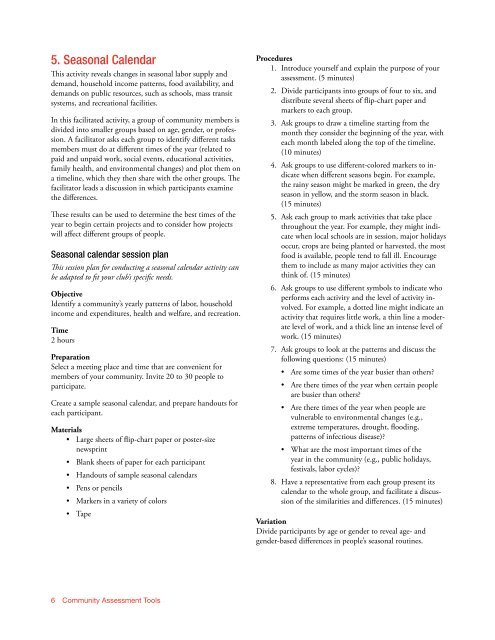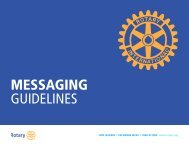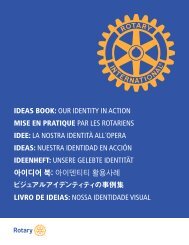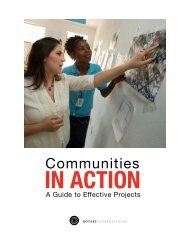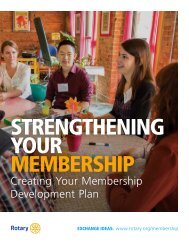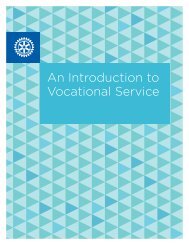Community Assessment Tools
Rotary International a companion piece to communities in action
Rotary International a companion piece to communities in action
You also want an ePaper? Increase the reach of your titles
YUMPU automatically turns print PDFs into web optimized ePapers that Google loves.
5. Seasonal Calendar<br />
This activity reveals changes in seasonal labor supply and<br />
demand, household income patterns, food availability, and<br />
demands on public resources, such as schools, mass transit<br />
systems, and recreational facilities.<br />
In this facilitated activity, a group of community members is<br />
divided into smaller groups based on age, gender, or profession.<br />
A facilitator asks each group to identify different tasks<br />
members must do at different times of the year (related to<br />
paid and unpaid work, social events, educational activities,<br />
family health, and environmental changes) and plot them on<br />
a timeline, which they then share with the other groups. The<br />
facilitator leads a discussion in which participants examine<br />
the differences.<br />
These results can be used to determine the best times of the<br />
year to begin certain projects and to consider how projects<br />
will affect different groups of people.<br />
Seasonal calendar session plan<br />
This session plan for conducting a seasonal calendar activity can<br />
be adapted to fit your club’s specific needs.<br />
Objective<br />
Identify a community’s yearly patterns of labor, household<br />
income and expenditures, health and welfare, and recreation.<br />
Time<br />
2 hours<br />
Preparation<br />
Select a meeting place and time that are convenient for<br />
members of your community. Invite 20 to 30 people to<br />
participate.<br />
Create a sample seasonal calendar, and prepare handouts for<br />
each participant.<br />
Materials<br />
• Large sheets of flip-chart paper or poster-size<br />
newsprint<br />
• Blank sheets of paper for each participant<br />
• Handouts of sample seasonal calendars<br />
• Pens or pencils<br />
• Markers in a variety of colors<br />
• Tape<br />
Procedures<br />
1. Introduce yourself and explain the purpose of your<br />
assessment. (5 minutes)<br />
2. Divide participants into groups of four to six, and<br />
distribute several sheets of flip-chart paper and<br />
markers to each group.<br />
3. Ask groups to draw a timeline starting from the<br />
month they consider the beginning of the year, with<br />
each month labeled along the top of the timeline.<br />
(10 minutes)<br />
4. Ask groups to use different-colored markers to indicate<br />
when different seasons begin. For example,<br />
the rainy season might be marked in green, the dry<br />
season in yellow, and the storm season in black.<br />
(15 minutes)<br />
5. Ask each group to mark activities that take place<br />
throughout the year. For example, they might indicate<br />
when local schools are in session, major holidays<br />
occur, crops are being planted or harvested, the most<br />
food is available, people tend to fall ill. Encourage<br />
them to include as many major activities they can<br />
think of. (15 minutes)<br />
6. Ask groups to use different symbols to indicate who<br />
performs each activity and the level of activity involved.<br />
For example, a dotted line might indicate an<br />
activity that requires little work, a thin line a moderate<br />
level of work, and a thick line an intense level of<br />
work. (15 minutes)<br />
7. Ask groups to look at the patterns and discuss the<br />
following questions: (15 minutes)<br />
• Are some times of the year busier than others?<br />
• Are there times of the year when certain people<br />
are busier than others?<br />
• Are there times of the year when people are<br />
vulnerable to environmental changes (e.g.,<br />
extreme temperatures, drought, flooding,<br />
patterns of infectious disease)?<br />
• What are the most important times of the<br />
year in the community (e.g., public holidays,<br />
festivals, labor cycles)?<br />
8. Have a representative from each group present its<br />
calendar to the whole group, and facilitate a discussion<br />
of the similarities and differences. (15 minutes)<br />
Variation<br />
Divide participants by age or gender to reveal age- and<br />
gender-based differences in people’s seasonal routines.<br />
6 <strong>Community</strong> <strong>Assessment</strong> <strong>Tools</strong>


